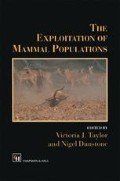Synopsis
Game ranching originated in Africa. Parameters for measuring productivity in nine popular ranching ungulate species are examined, as are management and economic considerations. Many wild ungulates have evolved in Africa, yet attempts at domestication have been spasmodic and seemingly ineffectual. Although these species are apparently well suited to game ranching, only limited research has so far been carried out. Suggestions are made regarding future research.
Access this chapter
Tax calculation will be finalised at checkout
Purchases are for personal use only
Preview
Unable to display preview. Download preview PDF.
References
Dasmann, R.F. (1964) African Game Ranching, Pergamon Press, Oxford.
Davies, R.A.G. and Skinner, J.D. (1986) Spatial utilization of an enclosed area of the Karoo by springbok Antidorcas marsupialis and Merino sheep Ovis aries during drought. Trans. Roy. Soc. S. Afr., 46, 115–132.
Estes, R.R.D. (1966) Behaviour and life history of the wildebeest (Connochaetes taurinus Burchell). Nature, 212, 999–1000.
Gericke, M.D., Hofmeyr, J.M. and Louw, G.N. (1978) The effect of capture stress and haloperidol therapy on the physiology and blood chemistry of springbok, Antidorcas marsupialis. Madoqua, 11, 5–18.
Hall-Martin, A.J., von La Chevallerie, M. and Skinner, J.D. (1977) Carcass composition of the giraffe Giraffa camelopardalis giraffa. S. Afr. J. Anim. Sci., 7, 47–50.
Huntley, B.J. (1971) Carcass composition of mature male blesbok and kudu. S. Afr. J. Anim. Sci., 1, 125–128.
Ledger, H.P. (1963) A note on the relative body composition of wild and domestic ruminants. Bull. Epiz. Dis. Afr., 11, 163–165.
Marais, A.L. and Skinner, J.D. (1993) The effect of the ram on synchronisation of oestrus in blesbok ewes. J. Afr. Ecol., 31, 253–260.
Mason, D.R. (1982) Studies on the biology and ecology of the warthog Phacochoerus aethiopicus sundevalli. Lonnberg 1908, PhD thesis, University of Pretoria.
Methuen, H.H. (1848) Life in the Wilderness; or Wanderings in South Africa, Richard Bentley, London.
Murray, M.G. (1982) The rut of impala: aspects of seasonal mating under tropical conditions. Z. Tierpsychol., 59, 319–337.
Posselt, J. (1963) The domestication of the eland. Rhod. J. Agric. Res., 1, 81–87.
Sinclair, A.R.E. (1977) Lunar cycle and timing of mating season in Serengeti wildebeest. Nature, 267, 832–833.
Skinner, J.D. (1967) An appraisal of the eland as a farm animal in Africa. Anim. Breed. Abstr., 35, 177–186.
Skinner, J.D. (1975) Game farming in South Africa. J. S. Afr. Biol. Soc., 16, 8–15.
Skinner, J.D. (1989) Game ranching in southern Africa, in Wildlife Production Systems (eds R.J. Hudson, K.R. Drew and L.M. Baskin), Cambridge University Press, Cambridge.
Skinner, J.D. and Van Jaarsveld, A.S. (1987) Adaptive significance of restricted breeding in southern African ruminants. S. Afr. J. Sci., 83, 657–663.
Skinner, J.D. and van Zyl, J.H.M. (1969) Reproductive performance of the common eland Taurotragus oryx in two environments. J. Reprod. Fert., Suppl. 6, 319–322.
Skinner, J.D., Jackson T. and Marais, A.L. (1990) The ‘ram effect’ in three species of African ungulates, in Proc. Int. Symp. ‘Ongules/Ungulates 1991’, (eds F. Spitz, G. Janeau, G. Gonzalez and S. Aulagnier), SFEPMIRGM, Toulouse, pp. 565–568.
Skinner, J.D., van Aarde, R.J., Knight, M.H. and Dott, H.M. (in press) Morphometries and reproduction in a population of springbok Antidorcas marsupialis in the semi-arid southern Kalahari. Afr. J. Ecol.
Swank, W.G., Casebeer, R.L., Thresher, P.B. and Woodford, M.H. (1974) Cropping, Processing and Marketing of Wildlife in Kajiado District, Kenya, Government of Kenya and FAO, Nairobi.
von La Chevallerie, M. (1970) Meat production from wild ungulates. Proc. S. Afr. Soc. Anim. Prod., 9, 73–87.
von La Chevallerie, M. (1972) Meat quality in seven wild ungulate species. S. Afr. J. Anim. Sci., 2, 101–104
von La Chevallerie, M. and van Zyl, J.H.M. (1971) Growth and carcass development of the springbok Antidorcas marsupialis. Agroanimalia, 3, 115–121.
Editor information
Editors and Affiliations
Rights and permissions
Copyright information
© 1996 Chapman & Hall
About this chapter
Cite this chapter
Skinner, J.D. (1996). Game ranching. In: Taylor, V.J., Dunstone, N. (eds) The Exploitation of Mammal Populations. Springer, Dordrecht. https://doi.org/10.1007/978-94-009-1525-1_5
Download citation
DOI: https://doi.org/10.1007/978-94-009-1525-1_5
Publisher Name: Springer, Dordrecht
Print ISBN: 978-94-010-7182-6
Online ISBN: 978-94-009-1525-1
eBook Packages: Springer Book Archive

